|
Click Here to return to Boston Illustrated Content Page Click Here to return to Previous Chapter |
 (HOME) |
|
Click Here to return to Boston Illustrated Content Page Click Here to return to Previous Chapter |
 (HOME) |
|
The West End, Continued.
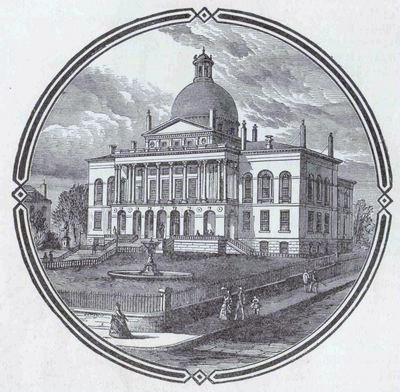 State House. There are very few spots on the Common with which some Bostonian has not a pleasant association. Almost every citizen and visitor has rejoiced in the grateful shade of the Tremont Street Mall, or the arching elms of the Beacon Street Mall, on a hot summer’s day. But the associations are by no means confined to the mere experience of comfort beneath the shadow of these wide-spreading trees. The inimitable Dr. Holmes has laid the scene of one of the pleasantest courtships in literature at the head of one of the malls branching from the one which our view represents. The “Autocrat of the Breakfast-Table” had engaged passage for Liverpool, that he might escape forever from the sight of the fascinating schoolmistress if she turned a deaf ear to his petition. Having thus provided a way of escape, he planned to take a walk with her. 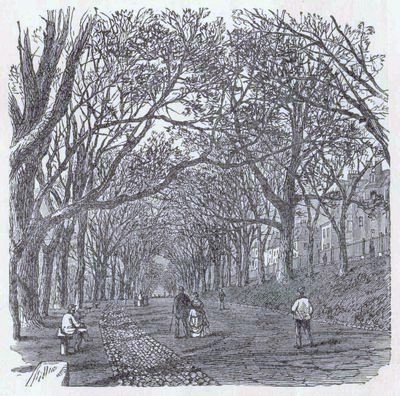 Beacon Street Mall. “It was on the Common that we were walking. The mall, or boulevard of our Common, you know, has various branches leading from it in different directions. One of these runs down from opposite Joy Street, southward across the length of the whole Common to Boylston Street. We called it the long path, and were fond of it. “I felt very weak indeed (though of a thoroughly robust habit), as we came opposite the head of this path on that morning. I think I tried to speak twice without making myself distinctly audible. At last I got out the question, ‘Will you take the long path with me?’ ‘Certainly,’ said the schoolmistress, ‘with much pleasure.’ ‘Think,’ I said, ‘before you answer; if you take the long path with me now, I shall interpret it that we are to part no more!’ The schoolmistress stepped back with a sudden movement, as if an arrow had struck her. “One of the long granite blocks used as seats was hard by, the one you may still see close by the Ginko-tree ‘Pray, sit down.’ I said. ‘No, no,’ she answered, softly, ‘I will walk the long path with you.’” The history of the Public Garden is shorter and less interesting than that of the Common. Before the improvement of this part of the city was begun, a large part of what is now the Public Garden was covered by the tides, and the rest was known as “the marsh at the foot of the Common.” In 1794, the old ropewalks having been burned, the town voted to grant these fiats for the erection of new ones. It was not until many years later that the folly of this act was seen, — indeed, not until after the construction of the Mill-dam, now the extension of Beacon Street, to Brookline. When the tide had ceased to flow freely oven the flats, and the marsh so rashly granted had become dry land, the hold-era of this property, having once more lost their ropewalks by fire, in 1819, begun to realize its value, and proposed to sell it for business and dwelling purposes. Charles Street had been laid out in 1803, and this increased the value of building-lots on the tract, if it could be sold. The proposed action was, however, resisted, and finally, in 1824, the city paid upwards of $50,000 to regain what the town had, in a fit of generosity, given away. But for a long time after this very little was done to ornament and improve the Public Garden. There was, until 1859, when an act of the Legislature and a vote of the city settled the question finally, a small bet earnest party in favor of disposing of the entire tract for building purposes. In the last twenty years much has been done to make the Public Garden very attractive; and in recent years especial care has been bestowed upon the arrangement and cultivation of its flower-beds. One of the latest additions to the features of the Garden is its illumination nightly by the electric light. 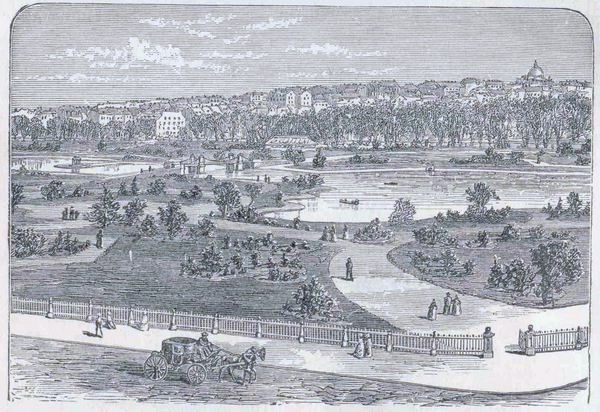 The Public Garden, from Arlington Street. 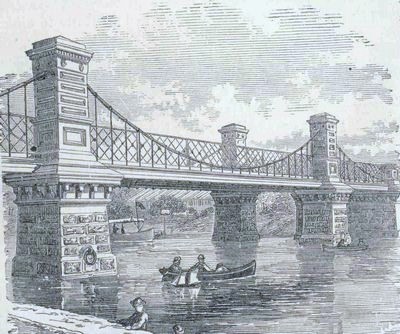 The Bridge, Public Garden The area of the park is about twenty-four and a quarter acres. The Boylston Street side is longer than the Beacon Street, and the Charles Street longer than the Arlington Street side. The pond in the centre is laboriously irregular in shape, and is wholly artificial. It contains rather less than four acres, and was constructed in 1859, almost immediately after the act of the Legislature relating to the Public Garden had been accepted. The central walk, from Charles to Arlington Streets, crosses this pond by an iron bridge resting on granite piers, erected in 1867. The appearance of unnecessary solidity and strength which this bridge presents gave point to numerous jokes in the newspapers of the day, by one of which it was called the “Bridge of Size.” The bridge is certainly strong enough to support an army on the march, and it looks much more substantial than it really is; but there is very little opportunity for unfavorable criticism of the structure. The title of “Monumental City,” so long borne by Baltimore, now belongs more surely to Boston, where public memorials of various forms appear on every side, from the costly erections on Bunker Hill and the Soldiers’ Monument, to the statues which are placed upon the squares and public grounds in various sections. So important has this feature become, and so large are the possibilities of its future development, that the Boston Memorial Association has been formed among the best men of the city, wisely and skillfully to direct and supervise the decoration of the streets, and to protect the interests of the highest art and the best aesthetic culture in this manner. There are several interesting works of art in the Public Garden. The one first placed there was a small hut very beautiful statue of Venus Rising from the Sea, which stands near the Arlington Street entrance, opposite Commonwealth Avenue. The fountain connected with this statue is so arranged as to throw, when it is playing, a fine spray all about the figure of Venus, producing a remarkably beautiful effect. Further towards Beacon Street stands the monument to “Commemorate the discovery that the inhaling of Ether causes Insensibility to Pain,” presented by Thomas Lee, Esq., and dedicated in June, 1868. In the centre of the Beacon Street side stands the statue in bronze of the late Edward Everett. The funds for this statue were raised by a public subscription, in 1865. The remarkable success of this subscription has already been referred to. This statue was modelled in Rome by Story, in 1866, cast in Munich, and presented to the city in November, 1867. The orator stands with his head thrown back, and with his right arm extended in the act of making a favorite gesture. 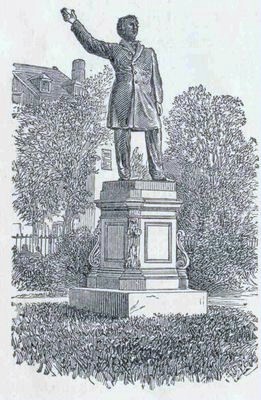 The Everett Statue. But the most conspicuous of all the works of art in the Public Garden is Ball’s great equestrian statue of Washington, which stands in the midst of the central path near the Arlington Street main entrance. It is justly regarded by many as one of the finest, as it is one of the largest, pieces of the kind in America. The movement which resulted in the erection of this monument was begun in the spring of 1859. The earliest contribution to the fund was the proceeds of an oration delivered by the Hon. Robert C. Winthrop in the Music Hall less than a month after the committee was organized. A great fair held in the same place in November of the same year, and an appropriation of ten thousand dollars from the city, supplied the greater part of the needful funds, supplemented in 1868 by a contribution of five thousand dollars of the surplus remaining after the erection of the statue of Everett just mentioned. The statue was unveiled on the 3d of July, 1869. It is a matter of no little local pride that all the artists and artisans employed in its production were furnished by Massachusetts. The statue represents Washington at a different period of his life from that usually selected by artists, and is all the more effective and original on that account. The outline is graceful, and perfectly natural from every point of view, and the work reveals new beauties the more it is examined. It was cast in fourteen pieces, but the joints are invisible. The extreme height of the pedestal and statue is thirty-eight feet, the statue itself being twenty-two feet high. The foundation, which rests upon piles, is of solid masonry eleven feet deep. The lamented Governor Andrew was one of the original committee which undertook the direction of this work, but he died before its completion. 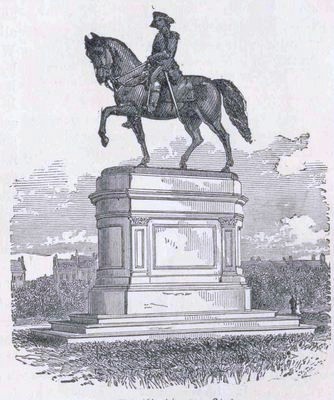 The Washington Statue. On the Boylston Street side of the Public Garden is the bronze statue of Charles Sumner, by Thomas Ball, erected in 1878, at a cost of 15,000. It represents Sumner as standing, with a roll of manuscript in the left hand, while the right hand is extended downward in gesture. On the same side of the Public Garden, but nearer Arlington Street, is the recently erected granite statue of Colonel Cass. 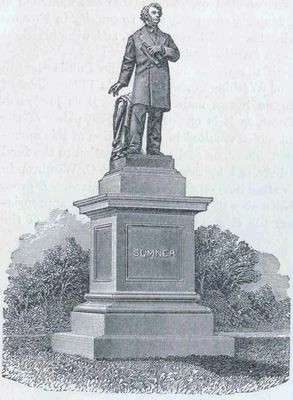 The Sumner Statue. It has been remarked that the irregular piece of territory bounded by Beacon, Tremont, and Park Streets was originally a part of the Common. Within this territory, and close by one of the busiest spots in Boston, is the Old Granary Burying-ground, one of those ancient landmarks which the good sense and good taste of its citizens have thus far preserved. In 1660 it became necessary to appropriate new space to resting-places for the dead, and the thrifty habits of our forefathers would not suffer them to buy land for the purpose when they were already in possession of a great tract lying its common. Accordingly, in the year before-mentioned, this graveyard was established. Two years afterwards, other portions of the territory now lost to the Common wore appropriated for sites for the bridewell, house of correction, almshouse, and public granary. The last-named building, which stood at first near the head of Park Street, and afterwards on the present site of the Park Street meeting-house, gave to the burying-ground the name by which it is so commonly designated. This is, without exception, the most interesting of the old Boston graveyards. Within this little enclosure lie the remains of some of the most eminent men in the history of Massachusetts and the country. The list includes no less than nine Governors of the Colony and State; three of the signers of the Declaration of Independence; Paul Revere, the patriotic mechanic; Peter Faneuil, the donor of the market-house and hall that bear his name; Judge Samuel Sewall; six famous doctors of divinity; the first mayor of Boston; and a great many others of whom every student of American history has read. Upon the front of one of the tombs, on the side next to Park Street Church, was once a small marble slab with the inscription, “No. 16. TOMB OF HANCOCK;” but nothing now marks the resting-place of the famous first signer of the Declaration of Independence, and the first Governor of - Massachusetts under the Constitution. In another part of the yard is the grave of the great Revolutionary patriot and Governor of the Commonwealth, Samuel Adams. Near the Tremont House corner of the burying-ground are the graves of the vie-tints of the Boston Massacre of 1770. The most conspicuous monument is that erected in 1827 over the grave where repose the parents of Benjamin Franklin; it contains the epitaph composed by the great man, who, “in filial regard to their memory, placed this stone.” Even the briefest reference to the notable persons who lie buried here would extend this sketch unduly. The stranger will find the list with sufficient fullness displayed upon the bronze tablets fixed, by order of the city authorities, upon the gates of the main entrance to the yard. For many years a row of stately elms stood along the sidewalk in front of the Old Granary Burying-ground. They were imported from England, and after having been for a time in a nursery at Milton, were set out here by Captain Adino Paddock, from whom the mall took its name, in or about 1762. Paddock was a loyalist, and a leader of the party in Boston. He left town with the British troops in 1776, removed to Halifax, and thence went to England; but upon receiving a government appointment in the Island of Jersey he removed thither, and lived there until his death, in 1804. He was a carriage-builder, and his shop stood opposite the row of trees which he planted and cared for. The elms were carefully protected during the occupation of the town by the British. Until 1873 their right to cast a grateful shade upon the throng of pedestrians constantly passing and repassing on Tremont Street was respected. But in spite of very strong remonstrances they were in that year cut down. 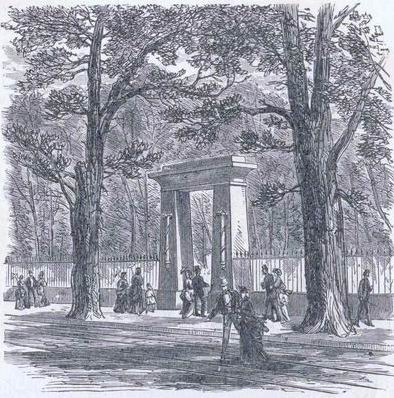 Entrance to the Granary Burying-ground. The Park Street church which stands between the Granary Burying-ground and the Common is one of the leading churches of the Trinitarian Congregational denomination. It was established in 1809. Its pastors have been able and popular men; among them the Rev. A. L. Stone, and the Rev. W. H. H. Murray, who, after filling the pastorate for more than six years, preached for some time to an independent church which he formed in Music Hall. The church at this time (March, 1891) is a without a pastor, an the Rev. Dr. David Gregg having resigned.  Park Street Church. On Park Street, which until recent years was prominent among the favorite streets in the city for dwelling-houses, are the rooms of the New England Woman’s Club at No. 5; the Boston headquarters of the publishing house of Houghton, Muffin & Company, at No. 4, with the editor’s room of the Atlantic Monthly; the Union Club, No. 8; and next the corner of Beacon Street the stately house long the residence of the late George Ticknor. Our engraving gives a view of Park Street with the Ticknor mansion and the Union club-house in the fore-ground. The former was erected many years ago, and was used as a residence till 1885, when it was altered over for business purposes. The original owner erected this and the two adjoining dwelling-houses on Beacon Street as a single residence, but the plan was afterwards changed, and what was originally intended for one dwelling-house became three, all of ample size. Mr. Ticknor bought his estate of the late Harrison Gray Otis, and began to reside there about the year 1830; and it was his Boston home until his death in 1870. 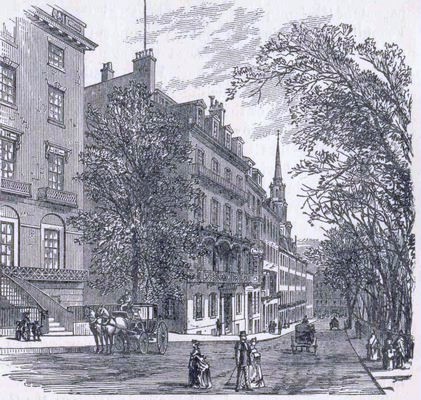 View of Park Street. |